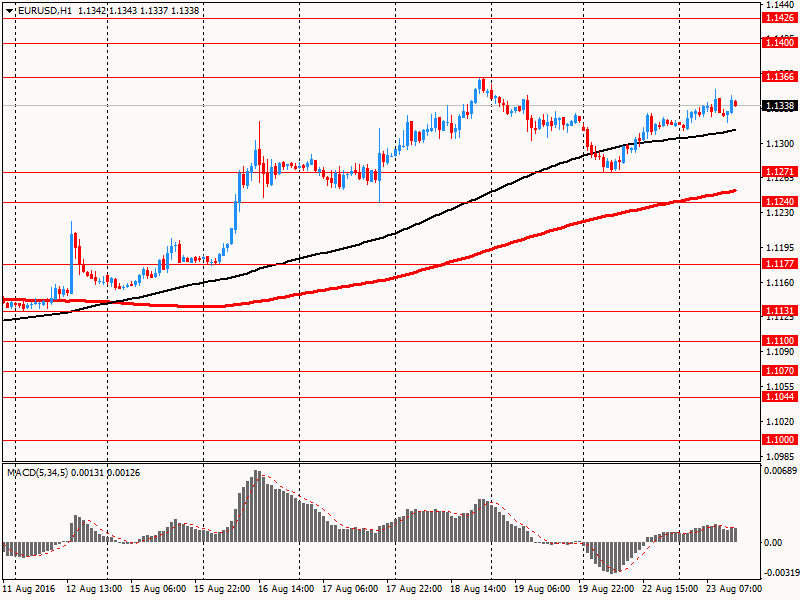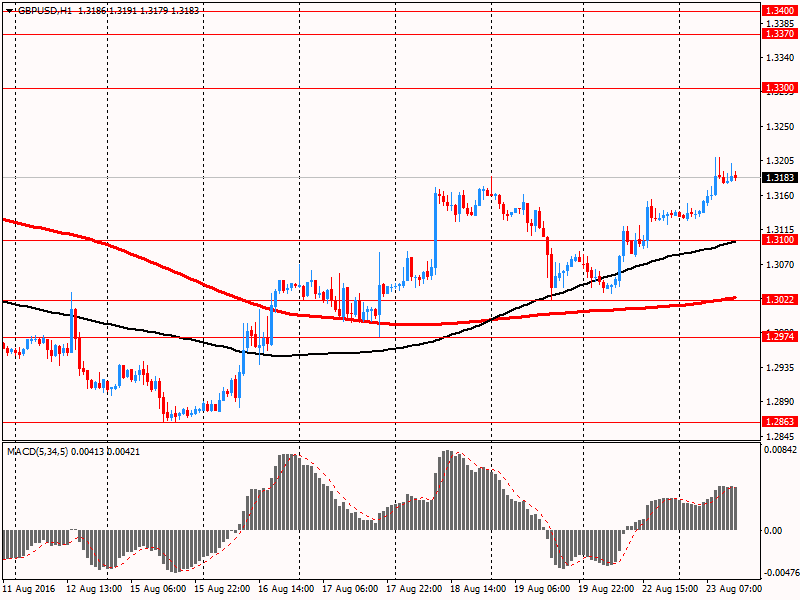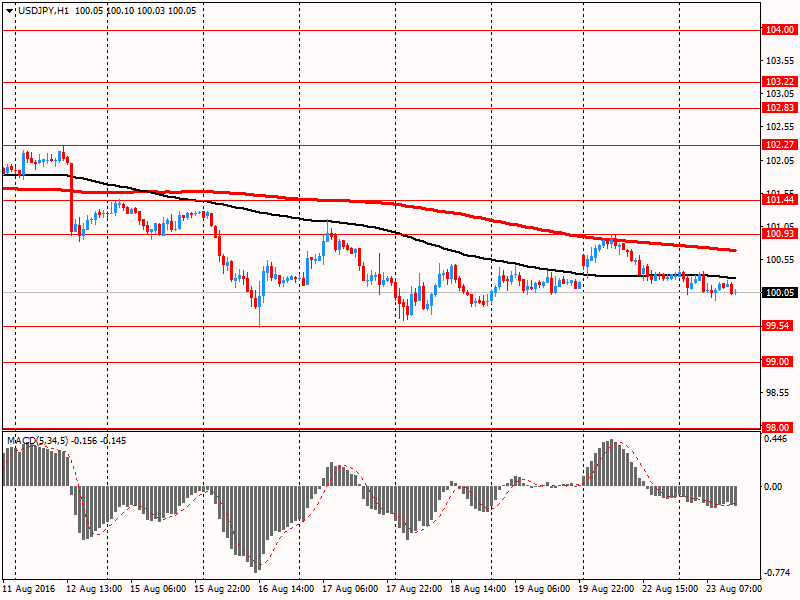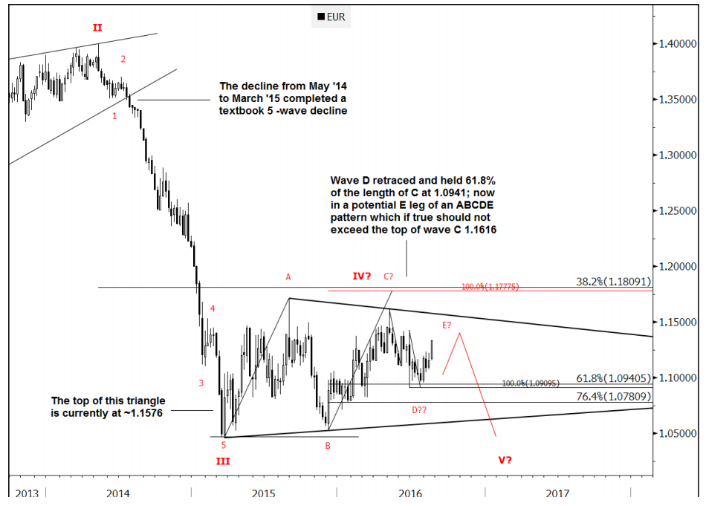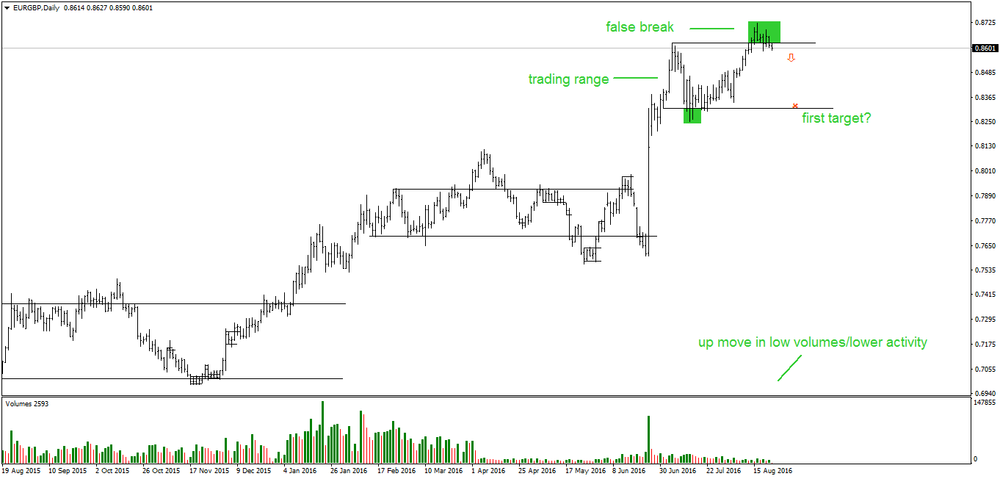Noticias del mercado
-
23:59
Schedule for today, Wednesday, Aug 24’2016
(time / country / index / period / previous value / forecast)
01:30 Australia Construction Work Done Quarter II -2.6% -1.9%
05:00 Japan Leading Economic Index (Finally) June 99.7 98.4
05:00 Japan Coincident Index (Finally) June 109.9 110.5
06:00 Germany GDP (QoQ) (Finally) Quarter II 0.7% 0.4%
06:00 Germany GDP (YoY) (Finally) Quarter II 1.5% 3.1%
08:30 United Kingdom BBA Mortgage Approvals July 40.1 38.5
13:00 Belgium Business Climate August 1 1
13:00 U.S. Housing Price Index, m/m June 0.2% 0.3%
14:00 U.S. Existing Home Sales July 5.57 5.51
14:30 U.S. Crude Oil Inventories August -2.5
-
16:21
U.S. new-home sales surged to the highest in nearly eight years - Marketwatch
U.S. new-home sales surged to the highest in nearly eight years in July as builders picked up the pace while buyer demand remained robust.Sales of newly constructed homes rose 12.4% to a seasonally adjusted annual rate of 654,000, the Commerce Department said Tuesday. That was 31.3% higher than a year ago, and easily beat forecasts of a 581,000 pace from economists surveyed by MarketWatch.June's figure was revised downward slightly, to 582,000.The median sales price in July was $294,600, 0.5% lower than year-ago levels. As sales soared, supply dwindled to 4.3 months' worth of homes at the current pace - Marketwatch.
-
16:19
Euro area consumer confidence declines in August
In August 2016, the DG ECFIN flash estimate of the consumer confidence indicator remained broadly stable in the EU (-0.1 points to -7.8) 3 , while it decreased in the euro area (by 0.6 points to -8.5) compared to July.
-
16:00
Eurozone: Consumer Confidence, August -8.5 (forecast -7.6)
-
16:00
U.S.: New Home Sales, July 654 (forecast 580)
-
15:59
U.S.: Richmond Fed Manufacturing Index, August -11 (forecast 6)
-
15:50
US manufacturing PMI lower in August
U.S. goods producers saw a further upturn in overall business conditions during August, though the rate of improvement was softer than seen in July. While output continued to rise markedly, total new work rose at a slower pace and employment expanded at the weakest rate in four months. Meanwhile, companies reported near-stagnant price trends overall, with input prices rising only marginally and companies leaving their prices charged unchanged from the previous month. The seasonally adjusted Markit Flash U.S. Manufacturing Purchasing Managers' Index™ (PMI) 1 registered at 52.1 in August down from 52.9.
-
15:50
Option expiries for today's 10:00 ET NY cut
EURUSD: 1.1200-1.1205 (EUR 455 M), 1.1260 (EUR 1,008 M), 1.1299-1.1300 (EUR 1,074 M), 1.1325-1.1340 (EUR 330 M), 1.1349-1.1355 (EUR 797 M)
USDJPY: 100.30 (USD 250 M), 100.40-100.55 (USD 429 M)
GBPUSD: 1.2999-1.3000 (GBP 389 M)
AUDUSD: 0.7425-0.7430 (AUD 194 M)
USDCAD: 1.2840-1.2850 (USD 287 M), 1.2890-1.2900 (USD 272 M), 1.2999-1.3000 (USD 365 M), 1.3040 (USD 780 M), 1.3075 (USD 420 M)
NZDUSD: 0.7225 (NZD 329 M)
-
15:45
U.S.: Manufacturing PMI, August 52.1 (forecast 52.7)
-
14:41
European session review: the pound has appreciated strongly against the dollar
The following data was published:
(Time / country / index / period / previous value / forecast)
Switzerland 6:00 Trade balance, bn in July 3.55 3.79 2.93
7:00 France Business activity index in the services sector (provisional) in August 50.5 50.5 52
France 7:00 PMI in the manufacturing sector (provisional) in August 48.6 48.8 48.5
7:30 Germany Index of business activity in the services sector (provisional) in August 54.4 54.4 53.3
7:30 Germany Index of business activity in the manufacturing sector (provisional) in August 53.8 53.5 53.6
8:00 Eurozone PMI in the manufacturing sector (preliminary data) August 52 52 51.8
8:00 Eurozone business activity index in the services sector (provisional) in August 52.9 52.8 53.1
10:00 UK Balance industrial orders Confederation of British Industry in August -9 -4 -5
The euro strengthened moderately against the US dollar, reaching 19 August high. The euro was supported by the data on business activity. A preliminary report from Markit Economics showed that the euro zone's private sector continued to expand in August, and recorded the fastest pace in 7 months. The composite PMI index, which covers the manufacturing sector and the service sector rose to 53.3 in August from 53.2 in July. Economists had expected the index to decline to 53.1. However, a preliminary index of business activity in the services sector rose to 53.1 from 52.9 a month earlier. The manufacturing PMI dropped to 51.8 against 52.0 in July. The German private sector expanded at a slower rate - the composite index fell to 54.4 from 55.3. Meanwhile, the French private sector recorded the fastest growth rate in 10 months - the composite index improved to 51.6 from 50.1.
Investors also adjusted their positions ahead of the release of the US statistics, namely the manufacturing PMI index and data on new home sales. According to forecasts, the PMI index fell to 52.7 from 52.9 in July, while sales of new homes fell in July 580 thousand to 592 thous.
At the same time, the market focus gradually shifted to the speech of Fed Yellen at the symposium in Jackson Hole, which will take place on Friday and could shed light on certain issues. Some experts believe that the statement may signal whether the Fed sees a strong enough economic momentum, which would allow to raise interest rates in September or in the coming months. According to the futures market, the probability of a Fed rate hike is 15% in September and 40.9% in December against 39.9% the previous day.
The British pound rose significantly against the dollar, updating the 3-week high. Later this week, analysts will analyze the Brexit impact on the UK economy. On Thursday we have the index of retail sales of the Confederation of British Industry (CBI), which will show whether consumer spending rebounded in August. On Friday, data on investment in the 2nd quarter will show what influence the uncertainty in connection with the referendum had on the plans for capital investment. The Bank of England is worried that companies could postpone investment until the situation of the UK and the EU will be clearer.
EUR / USD: during the European session, the pair rose to $ 1.1354
GBP / USD: during the European session, the pair has risen to $ 1.3208
USD / JPY: during the European session, the pair fell to Y99.93
-
14:30
The surplus of trade between Russia and the EU countries for the first half of the year decreased
The trade balance of the Russian Federation and the European Union for the first half of 2016 remains positive, however, the surplus fell in half compared to the same period last year and amounted to $ 29.1 billion, according to data from the Federal Customs Service (FCS) for January -. June 2016.
The trade surplus of the Russian Federation and the EU in the first half of 2015 amounted to $ 58.6 billion.
-
14:11
Orders
EUR/USD
Offers 1.1350-55 1.1380-85 1.1400 1.1425-30 1.1450
Bids 1.1330 1.1310 1.1300 1.1270 1.1250 1.1230 1.1200 1.1185 1.1150
GBP/USD
Offers 1.3225-30 1.3250 1.3280 1.3300 1.3320 1.3350
Bids 1.3175 1.3150 1.3130 1.3100 1.3085 1.3050 1.3025-30 1.3000
EUR/GBP
Offers 0.8625-30 0.8655-60 0.8685 0.8700 0.8725-30 0.8750
Bids 0.8585 0.85700.8550 0.8530 0.8500
EUR/JPY
Offers 113.80 114.00 114.30 114.50 114.75 115.00
Bids 113.30-35 113.00 112.75-80 112.50 112.30 112.00-10
USD/JPY
Offers 100.20 100.30 100.50 100.85 101.00 101.25-30 101.50 101.75-80 102.00
Bids 99.85 99.6599.50 99.30 99.00 98.80 98.50 98.30 98.00
AUD/USD
Offers 0.7650-55 0.7680 0.7700 0.7725-30 0.7750-55
Bids 0.7620 0.7600 0.7585 0.7565 0.7550 0.7500
-
13:57
ECB, Coeure: Structural reforms - a key factor in uniform growth in Europe
- Long-term growth of the economy - a key factor in strengthening confidence in the European project.
- The ECB should take further action if structural reforms and fiscal policy are inadequate.
- The more the ECB is doing in terms of stimulus, the more pronounced side effects.
-
13:42
Japanese official, Fujii: Bank of Japan still needs to examine effects of negative rates
-
BOJ still needs to examine effects of negative rates though.
-
Japan needs JPY 10trln fiscal stimulus in FY 2017 and FY 2018 to escape deflation and offset lack of demand in the economy.
-
it's important for the Bank of Japan to maintain current policy.
-
-
12:42
Major European indices trading higher supported by mining shares
European stocks showing a strong increase, aided by the recovery of stocks of commodity producers and statistics on business activity in the euro area.
A preliminary report from Markit Economics showed that the euro zone's private sector continued to expand in August, and recorded the fastest pace in seven months. The composite PMI index, which covers the production sector and the service sector rose in August to 53.3 points compared with 53.2 points in July However, a preliminary index of business activity in the services sector rose to 53.1 points from 52.9 points a month earlier. It was predicted that the index will drop to 52.8. With regard to the manufacturing PMI in August, it dropped to 51.8 points versus 52.0 points in July. It became known that the German private sector expanded at a slower rate - the composite index fell to 54.4 points from 55.3 points in July. At the same time, the French private sector recorded the fastest growth in ten months - the composite index improved to 51.6 points from 50.1 points.
Oil prices declined amid reports that Iraq intends to increase the export of raw materials. In July, the export of Iraqi oil, according to the International Energy Agency, has reached 3.71 million barrels per day. The production volume was approximately 4.33 million barrels, which is 80 thousand higjer compared to June. In addition, investors are concerned about the likely return of oil production in Nigeria.
The composite index of Europe's largest enterprises Stoxx 600 added 0.7 percent. Shares of mining companies shows the greatest increase among the 19 industry which is associated with the approach of iron ore prices to two-week high.
Shares of BHP Billiton Ltd. and Glencore Plc rose 3.2 percent and 2 percent respectively.
UniCredit quotes rose 3.9 percent after a Polish newspaper reported that the leaders of PZU SA and representatives of the Polish State Development Fund will head to Milan to discuss the terms of the purchase of Bank Pekao SA.
The cost of Persimmon Plc climbed 4.7 percent after a strong first half of the year. In addition, the Chief Executive Officer Jeffrey Fairburn said he did not see any changes in consumer behavior since Brexit.
Securities of Straumann Holding AG increased 1.6 percent after the medical equipment manufacturer raised its full-year outlook for earnings.
Capitalization of Schneider Electric SE increased by 1.4 percent, as people familiar with the matter, said that the company is considering DTN sale for about $ 1.5 billion.
At the moment:
FTSE 100 +40.18 6868.72 + 0.59%
DAX +92.70 10587.05 + 0.88%
CAC 40 +32.42 4422.36 + 0.74%
-
12:14
UK: Export order books reached a two-year high - CBI
The survey of 505 firms found that export order books reached a two-year high, suggesting that the depreciation of sterling since the end of last year may be feeding through to stronger overseas demand. Chemical manufacturers accounted for just over half the improvement in export orders, with less than one-third of the 17 manufacturing sub-sectors reporting export orders at below normal levels.
Price expectations for the three months to November rose to their highest since February 2015, perhaps in response to the rise in the cost of imported raw materials following sterling's depreciation.
-
12:00
United Kingdom: CBI industrial order books balance, August -5 (forecast -9)
-
11:30
EUR/USD: Large Triangle Still In Place: Make Or Break Levels - Goldman Sachs
"The base case scenario remains for EURUSD to eventually continue its long-term trend. As has been discussed in the past, the currency has formed a triangle like consolidation since the Mar. '15 low. This is now getting closer to looking like a complete ABCDE.
Once complete, the market should in theory resume its underlying trend (i.e. commence wave V). This would mean eventually breaking through the base of the triangle (1.0588) and back down towards the Mar. '15 low (1.0458), if not significantly lower.
All of this is contingent on 1) the market holding below triangle resistance which is currently at 1.1576 and 2) wave E ending somewhere beneath the top of wave C which is up at 1.1616.
In other words, any break beyond 1.1576-1.1616 will seriously call into question the nature of this setup. Doing so would imply potential to have already put in a meaningful base.
View: Cautious above 1.1398-1.1427 (highs from June). Any move past 1.1576-1.1616 warns that a more meaningful low could already be in place".
Copyright © 2016 Goldman Sachs, eFXnews™
-
11:03
Option expiries for today's 10:00 ET NY cut
EUR/USD 1.1350 (EUR 605m)
USD/JPY 101.00 (USD 1.46bln) 103.00 (USD 877m) 104.00 (1.08bln)
AUD/USD 0.7650 (AUD 640m)
USD/CAD 1.2990-1.3000 (USD 756m)
AUD/NZD 1.0700 (AUD 310m) 1.0710-12 (AUD (485m)
-
10:07
The euro area economy continued to expand at a steady pace in August
- Flash Eurozone PMI Composite Output Index(1) at 53.3 (53.2 in July). 7-month high.
- Flash Eurozone Services PMI Activity Index(2) at 53.1 (52.9 in July). 3-month high.
- Flash Eurozone Manufacturing PMI(3) at 51.8 (52.0 in July). 3-month low.
- Flash Eurozone Manufacturing PMI Output Index(4) at 54.0 (53.9 in July). 8-month high.
The euro area economy continued to expand at a steady pace in August. At 53.3, up from 53.2 in July, the flash estimate of the Markit Eurozone PMI® inched up to a seven-month high. With the index only slightly above the average seen throughout the year to date, growth in the third quarter is likely to be similar to that seen in the first half of the year.
Chris Williamson, Chief Business Economist at IHS Markit said: "The August flash PMI indicates that the eurozone remains on a steady growth path in the third quarter, with no signs of the recovery being derailed by 'Brexit' uncertainty. "The survey data are consistent with the region's GDP growing at a quarterly rate of 0.3% in the third quarter, or 1.2% annualised, which is similar to that seen on average over the first half of the year.
-
10:00
Eurozone: Manufacturing PMI, August 51.8 (forecast 52)
-
10:00
Eurozone: Services PMI, August 53.1 (forecast 52.8)
-
09:48
-
09:35
German economy is continuing its uninterrupted upward trend in August - Markit
- Flash Germany PMI Composite Output Index(1) at 54.4 (55.3 in July). 2-month low.
- Flash Germany Services PMI Activity Index(2) at 53.3 (54.4 in July). 15-month low.
- Flash Germany Manufacturing PMI(3) at 53.6 (53.8 in July). 3-month low.
- Flash Germany Manufacturing Output Index(4) at 56.6 (57.0 in July), 2-month low.
Oliver Kolodseike, Economist at IHS Markit said: "Today's survey results highlight that the German economy is continuing its uninterrupted upward trend in August. However, output, new orders and employment all rose at slightly weaker rates during the month, thereby signalling that business conditions have become a bit more challenging since the prior month. "
-
09:31
Germany: Services PMI, August 53.3 (forecast 54.4)
-
09:31
Germany: Manufacturing PMI, August 53.6 (forecast 53.5)
-
09:05
France: lower manufacturing activity but services activity improves - Markit
The latest flash France PMI® data indicated that private sector output increased at the sharpest rate in ten months during August. The Markit Flash France Composite Output Index, based on around 85% of normal monthly survey replies, posted 51.6, up from 50.1 in July, to signal a moderate pace of expansion. Service providers reported a second successive monthly rise in business activity during August. Moreover, the rate of growth was the fastest since October 2015. In the manufacturing sector, output was stable following a four-month period of contraction.
New business across the French private sector increased for the second month running during August. That said, the rate of growth remained marginal overall and was slightly weaker than in July. Expansion was centred on the service sector, where new work intakes rose for a sixth consecutive month. In contrast, manufacturers' new order books fell for the eighth month in a row, with the rate of decline quickening since July (partly reflecting a return to contraction of new export orders).
Employment at French private sector companies decreased in August, having risen slightly in the preceding month. However, the rate of job shedding was modest overall. Manufacturers reported a steeper drop in staffing levels than service providers.
-
09:00
France: Services PMI, August 52 (forecast 50.5)
-
09:00
France: Manufacturing PMI, August 48.5 (forecast 48.8)
-
08:36
AUD will peak at USD 0.78 in Q3 2016, how to trade? - ANZ
"We forecast that the AUD will peak at USD 0.78 in Q3 2016. While our forecasts show a gradual depreciation from there, we expect that AUD will trade with some volatility in a USD0.70- 0.78 range before breaking lower in the latter half of 2017.
Given the uncertain nature of the timing of the depreciation, the current low level of volatility, and the skew present in the risk reversal, we recommend using options to capture this range. We recommend buying a 6 month AUD/USD0.74/0.71 put spread and selling a 6 month AUD/USD0.80 call at an indicative rate of AUD 24 pips".
Copyright © 2016 ANZ, eFXnews™
-
08:34
The sentiment in the Chinese business community from MNI decreased in August
The indicator of business confidence in August was 54.3, lower than the previous value of 55.5. This was the first decline in three months.
The indicator of business sentiment in China from MNI, whose data are based on a monthly survey of Chinese business leaders, monitors and forecasts economic conditions in China, and provides important information before official government data. Companies that participated in the study are registered in the domestic stock market or in Hong Kong, although some of them also have a foreign registration. The research group consists of about 75% manufacturing companies and 25% - non-manufacturing.
The index of business sentiment remains above the value of 50 for the fifth consecutive month.
Production rose to its highest level since September 2015. New orders decreased by 8.8%.
-
08:31
Options levels on tuesday, August 23, 2016:
EUR/USD
Resistance levels (open interest**, contracts)
$1.1455 (4685)
$1.1402 (4709)
$1.1370 (4627)
Price at time of writing this review: $1.1333
Support levels (open interest**, contracts):
$1.1261 (1305)
$1.1202 (1951)
$1.1167 (2786)
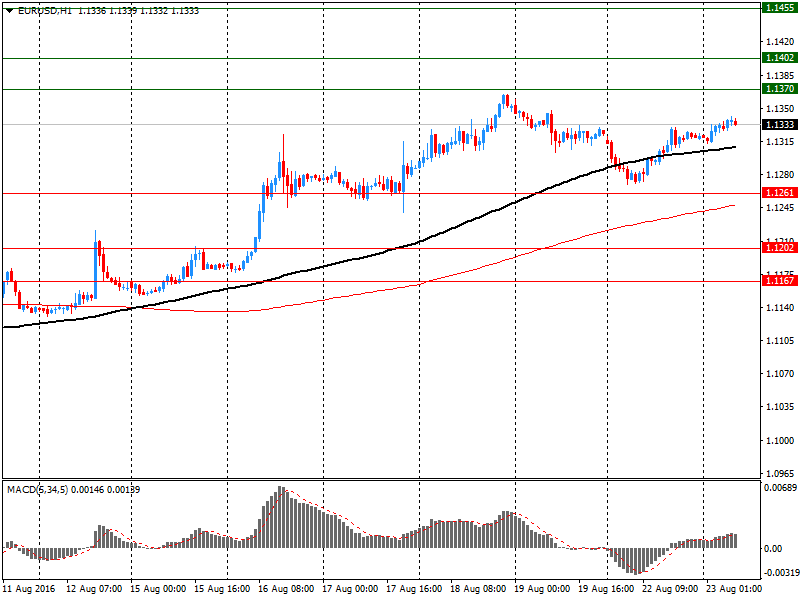
Comments:
- Overall open interest on the CALL options with the expiration date September, 9 is 53495 contracts, with the maximum number of contracts with strike price $1,1250 (4957);
- Overall open interest on the PUT options with the expiration date September, 9 is 57630 contracts, with the maximum number of contracts with strike price $1,1000 (5769);
- The ratio of PUT/CALL was 1.08 versus 1.07 from the previous trading day according to data from August, 22
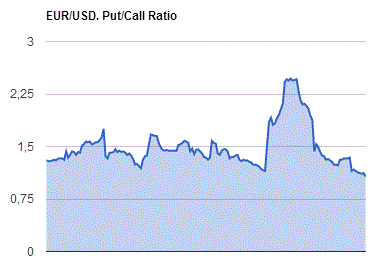
GBP/USD
Resistance levels (open interest**, contracts)
$1.3403 (2421)
$1.3305 (3028)
$1.3209 (1942)
Price at time of writing this review: $1.3158
Support levels (open interest**, contracts):
$1.3090 (1037)
$1.2994 (2028)
$1.2897 (1997)
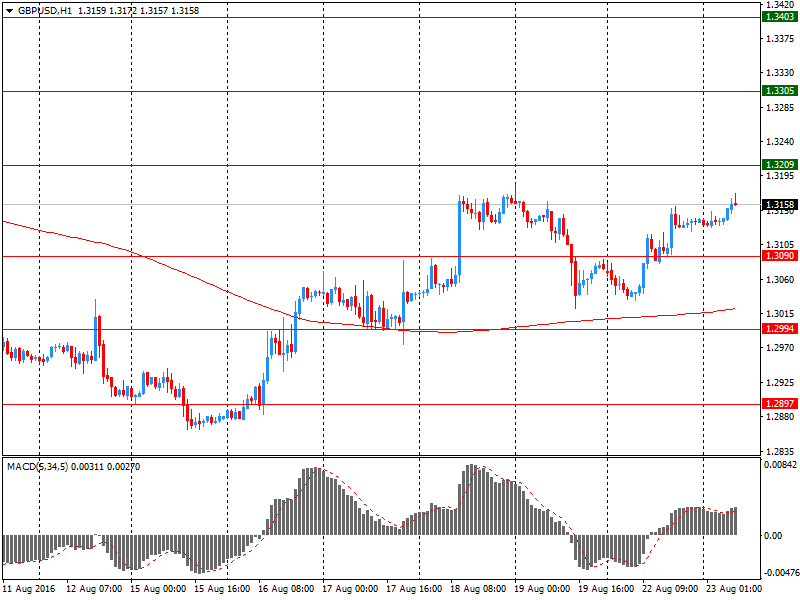
Comments:
- Overall open interest on the CALL options with the expiration date September, 9 is 32601 contracts, with the maximum number of contracts with strike price $1,3300 (3028);
- Overall open interest on the PUT options with the expiration date September, 9 is 26697 contracts, with the maximum number of contracts with strike price $1,2800 (2678);
- The ratio of PUT/CALL was 0.82 versus 0.82 from the previous trading day according to data from August, 22
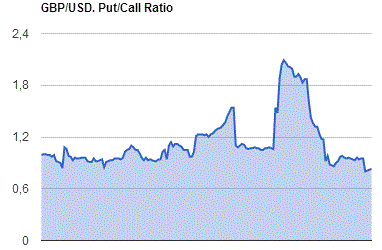
* - The Chicago Mercantile Exchange bulletin (CME) is used for the calculation.
** - Open interest takes into account the total number of option contracts that are open at the moment.
-
08:25
RBNZ, Wheeler: Monetary policy challenges in turbulent times
Rapid decreases in interest rates would likely result in an unsustainable surge in growth, capacity bottlenecks and further inflame an already seriously overheating property market, Reserve Bank of New Zealand Governor Graeme Wheeler said Tuesday.
"We do not believe that the outlook and balance of risks warrants a position of no policy change, nor a position of rapid easings," Wheeler said.
The bank encountered a view that it should not lower interest rates, because current robust economic growth makes interest rate cuts unwarranted and undesirable.
"An aggressive monetary policy that is seen as exacerbating imbalances in the economy would not be regarded as sustainable, and would not deliver the exchange rate relief being sought," said Wheeler.
He said the bank remains committed to the inflation goals. A flexible inflation targeting remains the most appropriate framework for conducting monetary policy in New Zealand.
The rationale for the rate cut in August was to lower the risk of a further fall in short-term inflation expectations - RTT news.
-
08:21
Swiss trade balance showed a surplus of CHF 2.9 billion
In July 2016 results covered exports minus two missing workdays. Adjusted exports were +7.9 % ( real terms : + 2.4% ) and imports increased by 11.8% ( in real terms : + 8.2% ). The trade balance showed a surplus of CHF 2.9 billion
-
08:17
Japan's manufacturing PMI below 50 in August
Flash Japan Manufacturing PMI™ at 49.6 in August (49.3 in July). The PMI signalled only a slight deterioration in the health of the sector that was the weakest in the current six-month sequence of decline. Flash Japan Manufacturing Output Index at 50.6 (49.4 in July). This highlighted the first increase in production since February (albeit marginal). Data collected 12- 19 August.
Today sees the latest public release of the Nikkei Flash Japan Manufacturing Purchasing Managers' Index™ (PMI™). Published on a monthly basis approximately one week before final PMI data are released, this makes the PMI the earliest available indicator of manufacturing sector operating conditions in Japan. The estimate is typically based on approximately 85%-90% of total PMI survey responses each month and is designed to provide an accurate indication of final PMI data.
-
08:01
Switzerland: Trade Balance, July 2.93 (forecast 3.79)
-
04:00
Japan: Manufacturing PMI, August 49.6 (forecast 49.5)
-
00:30
Currencies. Daily history for Aug 22’2016:
(pare/closed(GMT +3)/change, %)
EUR/USD $1,1320 -0,03%
GBP/USD $1,3138 +0,49%
USD/CHF Chf0,962 +0,19%
USD/JPY Y100,31 +0,10%
EUR/JPY Y113,55 +0,06%
GBP/JPY Y131,78 +0,59%
AUD/USD $0,7631 +0,09%
NZD/USD $0,7289 +0,26%
USD/CAD C$1,2937 +0,52%
-
00:00
Schedule for today, Tuesday, Aug 23’2016
(time / country / index / period / previous value / forecast)
02:00 Japan Manufacturing PMI (Preliminary) August 49.3
04:00 Japan BOJ Governor Haruhiko Kuroda Speaks
06:00 Switzerland Trade Balance July 3.55
07:00 France Services PMI (Preliminary) August 50.5 50.5
07:00 France Manufacturing PMI (Preliminary) August 48.6 48.8
07:30 Germany Services PMI (Preliminary) August 54.4 54.3
07:30 Germany Manufacturing PMI (Preliminary) August 53.8 53.5
08:00 Eurozone Manufacturing PMI (Preliminary) August 52 52
08:00 Eurozone Services PMI (Preliminary) August 52.9 52.8
10:00 United Kingdom CBI industrial order books balance August -4 -9
13:45 U.S. Manufacturing PMI (Preliminary) August 52.9 52.7
14:00 Eurozone Consumer Confidence (Preliminary) August -7.9 -7.6
14:00 U.S. Richmond Fed Manufacturing Index August 10
14:00 U.S. New Home Sales July 592 580
22:45 New Zealand Trade Balance, mln July 127
-
